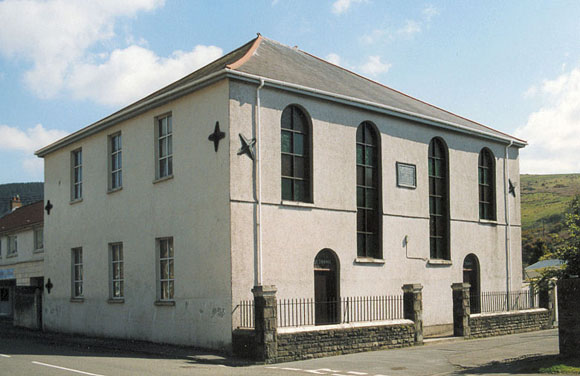|
Cwmavon - From 'A Topographical Dictionary of Wales' (1849)
CWMAVON, a manufacturing district, partly in the parish of Margam, hundred of Newcastle, but principally in that of Michaelston-superAvon, hundred of Neath, in the union of Neath, county of Glamorgan, South Wales, 2 miles (N. N. E.) from Aberavon; containing about 6000 inhabitants. The important iron, tin, and copper works at this place, which belong to the "Governor and Company of the Copper-miners of England," incorporated in 1691, are of comparatively recent establishment, and, before the discovery of blackbandironstone in this part of the county a few years ago, were much less extensive than they are at the present time. That discovery was made about the year 1843; the iron-trade at once received a considerable extension, and the subsequent increased demand for railway iron led to a corresponding increase of prosperity at Cwmavon and the other seats of the ironmanufacture. In 1845 the company raised as many as 134,556 tons of coal here. The mining and manufacturing works occupy altogether an area of 4000 acres, and, when in full operation, are capable of giving support to a population of 10,000.
The principal manufactures are, bar-iron, tinplates, fine copper, and chemicals; the average produce per annum, of finished iron, is 2400 tons, of tin-plates 50,000 boxes, and of pure copper 1800 tons. There are three collieries, seven furnaces for smelting the ironstone raised here, three refineries, three puddled bar and five bar iron mills, one sheetiron mill, two tin-mills, and two forges for hammered iron. The works for smelting the copper, which is imported, are 1200 feet long; they are covered by a double roof, and all the flues from the furnaces converge into one main culvert of stone, about 1500 feet in length, conveying the smoke from the works to the summit of the Voel mountain. Attached to these smelting-works are copper-rolling mills. There is also a brick-yard of large size, with a mill worked by water-power, and capable of making 100,000 bricks per week. The Depôt, erected in 1847, is said to be the largest establishment of the kind in Wales, the buildings comprising shops for pattern-makers, joiners, boiler and tram makers, and smiths; forges; brass and iron foundries; drilling, boring, planing, and punching machines, &c. About 320 horses can be accommodated in the range of stabling.
It is estimated that eighty miles of tramroad are in use, under ground, when the works are in full operation; and that, connected with the works, above ground, there are thirty miles of tramroad, on which three locomotive engines are in daily operation, conveying coal and ironstone, blackband included, from the different mines to the furnaces, and also conveying the various commodities in a finished state to Port-Talbot, three miles distant, for shipment. Power is furnished for some of the blast furnaces by a waterwheel, forty-five feet in diameter, with ten feet breast, and of ninety-horse power; to which the water is brought from the river Avon by means of a magnificent stone aqueduct, originally designed as a viaduct for a tramway to convey coal to the works. The aqueduct is 456 feet in length, and eighty feet high, and comprises four elliptical arches, each of seventy feet span, constructed of a strong grey stone raised on the spot; the whole erected at a cost of upwards of £7000. This noble structure, from its romantic situation across a narrow precipitous valley among the mountains, forms one of the most striking and interesting features of the district, and well deserves the attention of the tourist.
Cwmavon has been for some time past lighted with gas. There is a good house provided for the manager of the works, surrounded by an extensive paddock; also commodious houses for the agents belonging to the various departments, with upwards of 500 workmen's cottages having gardens attached; all the property of the company. The town contains a large market-place replete with every necessary convenience, which is chiefly supplied with vegetables and fruit from Somersetshire and Devonshire. Besides the parish church of Michaelston, there are six places of worship for dissenters, three of them for Calvinistic Methodists, one for Wesleyans, one for Baptists, and one for Independents; and in connexion with the works are three schools for boys, three schools for girls, and an infants' school, numbering altogether 850 children. The hill and mountain scenery intersected by the river Avon and its tributaries, especially in the vicinity of Oakwood, is much admired by the lovers of the picturesque and the romantic. It should be observed, that the foregoing account of the Cwmavon works applies to their state in October, 1848: they have since been advertised for sale.
|

